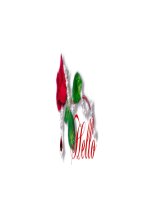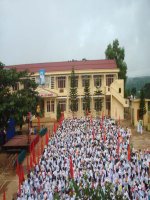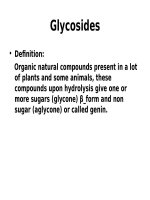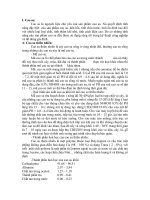Slide bài giảng Tìm hiểu về glycosides
Bạn đang xem bản rút gọn của tài liệu. Xem và tải ngay bản đầy đủ của tài liệu tại đây (134.47 KB, 52 trang )
Glycosides
•
Definition:
Organic natural compounds present in a lot of
plants and some animals, these compounds upon
hydrolysis give one or more sugars (glycone)
β_form and non sugar (aglycone) or called genin.
•
Solubility:
glycosides are water soluble compounds
and insoluble in the organic solvents.
Glycone part: water soluble, insoluble in
the organic solvents.
Aglycone part: water insoluble, soluble in
the organic solvents.
Some glycosides soluble in alcohol.
Separation between glycosides parts:
Glycosides glycone +aglycone +HCL
G + A +salt+H2O
(H2O+G)+A (H2O+G)+(chloroform+A)
We can separate them by using separatory
funnel
The best solvent to extract aglycone is Ethyl
acetate because:
A- immiscible in water.
B- always presents in the upper layer.
Neutralization by
Using alkaline
Filtration
chloroform
Hydrolysis
+HCLdil
Note:
Alcohol and acetone are water miscible
compounds,so we can't use them as
organic solvents for aglycone separation.
physico-chemical properties of
glycosides(general)
•
Colorless, solid, amorphous, nonvolatile
(flavonoid- yellow, anthraquinone-red or
orange.
•
Give positive reaction with Molisch's and
Fehling's solution test (after hydrolysis).
•
They are water soluble compounds,
insoluble in organic solvents
•
Most of them have bitter taste
(except: populin, glycyrrhizin, stevioside).
Cont
•
Odorless except saponin (glycyrrhizin).
•
when a glycosides has a lot of sugars its
solubility in water decrease.
•
Glycosides hydrolyzed by using mineral acids
and temperature or by using enzymes such as:
a- Emolsin Bitter almond seeds.
b- Myrosin or Myrosinase black mustard
seeds.
c- Rhamnase glycosides containing rhamnose
as sugar part.
Biosynthesis of glycosides
(O-glycosides)
•
UTP(Uridine Triphoshate) +sugar-1-phoshate
UDP-sugar + ppi(Pyrophosphate inorganic).
•
UDP-sugar +acceptor (aglycone)
Acceptor-sugar +UDP
Uridylyl transferase
Enzyme
Glycosyl transferase
Enzyme
Glycosyl transferase
Enzyme
The function or the role of
glycosides in the plant organism
•
Converting toxic materials to non or less
toxic.
•
Transfer water insoluble substances by
using monosaccharide.
•
Source of energy (sugar reservoir).
•
Storing harmful products such as phenol.
•
Regulation for certain functions(growth).
•
Some have beautiful colours(pollenation
process).
Cont…
•
Some glycosides have antibacterial
activity, so they protect the plants from
bacteria and diseases.
Bitter almond
Amygdalin
bacteria
HCN
hydrolysis
kill
Eomlsin
enzyme
Classification of glycosides
Classifications of glycosides
according to their therapeutic effects
•
CHF and cardiac muscles stimulators
such as:
a-Digitalis glycosides: digoxin, digitoxin, gitoxin
(Fox glove leaves).
b- Ouabain: Strophanthus gratus seeds.
c- K-strophanthin -Strophanthus kombe seeds.
d- Scillaren A,B which isolated from red and white
Squill bulbs.
e- Convolloside:Convallaria majalis – Lily of the
Valley.
Cont…
•
Laxative group of glycosides:
a- Sennoside A,B,C,D (Senna leaves and
fruits).
b- Cascaroside A,B (Cascara bark).
c- Frangulin and glucofrangulin(Frangula
bark).
d- Aloin and barbaloin (Aloe vera and Aloe
barbadensis juice).
Cont…
•
Local irritant group:
a-Sinigrin(Black mustered seeds_Brassica nigra)
b-Sinalbin(White mustered seeds_Brasica alba)
•
Analgesics and antipyretics:
Salicin Salisylic acid - Willow or Salix bark.
•
Keeping elasticity of blood vessels like:
Rutin_Rutoside (Bitter orange peels, Lemon peels)
•
Anti-inflammatory group:
a- Aloin for 1)acne 2)peptic ulcer
b-Glycyrrhizin
hydrolysis
Classification of glycosides
according to glycone part
•
Glucose _ glucoside group like in
Sennoside.
•
Rhamnose _ Rhamnoside like in
frangullin.
•
Digitoxose _ Digitoxoside like in digoxin.
•
Glucose and Rhammnose _
Glucorhamnoside _ glucofrangulin.
•
Rhamnose and glucose _
Rhamnoglucoside _ Rutin.
Classification of glycosides on the
basis of the linkage between glycone
and aglycone part
•
O-glycosides : in these glycosides the sugar part
is linked with alcoholic or phenolic hydroxyl or
carboxyl group.
•
S-glycosides : in these glycosides the sugar
attached to a Sulfur atom of aglycone such as in
sinigrin.
•
N-glycosides : in these glycosides the sugar
linked with Nitrogen atom of (-NH2,-NH-)amino
group of aglycone like in nucleosides DNA,RNA
•
C-glycosides : in these glycosides the sugar
linked (condensed) directly to Carbon atom of
aglycone like in aloin.
N.B C-glycosides are not hydrolyzed by acids or alkalis or by
enzymes mainly .
Classification of glycosides according to a glycone part :
1- if a glycone part alcohol -this group called alcoholic group like Salicin
2- if a glycone part aldehyde- this group called aldehydic gr. like
glucovanillin.
3- if phenol called phenolic group like arbutin .
4-if cyanone called cyanogenic or cyanophoric or cyanoside like
amygdalin.
5-if thio called glycosides or isothiocyanate glycoside like sinigrin or
sinalbin (-S=C=N-) (SCN)
6-anthracene > anthraquinone glycoside –sennoside
7-steroid steroidal glycoside (cardiac) Digoxin
8-flavone ,flavonol, flavanone –flavonoid glycoside
9-triterpenoid –saponin glycoside –glycyrrhizin ,melanthin (nigella
seeds) or ginsenoside .
Most of glycoside may be named according to the plant from which they isolated
for example:
1-salicin –salix-
2-cascaroside _cascara
3-aloin- Aloe vera
4- sennoside – senna-
5-frangulin – frangula
6- glycyrrhizin – glycyrrhiza
And others.
Always glycosides founded in the plant with the enzymes which hydrolyzed them.
We must damage these enzymes first to extract these glycoside by the following
steps:
1-drying the plants fresh in special oven at 100 c for 30 minutes.
2-boiling them with organic solvents for 20 minutes
3- boiling them with acetone 5 minutes
N.B.
If present in this plant tannins or resins we add lead acetate to precipitate them.
Classification of glycosides according to a glycone part.
1- phenolic group of glycosides:-
Such as arbutin which isolated from bearberry leaves
Uses: UTI as antiseptic and antibacterial & mild diuretic
Drugs :
-Esoterica :cream :age spots
-hydroquinone solution : wet hands
2- saponin group of glycoside
a. Important group of glycosides which widely distributed specially in the
higher plants parts
b. Most of them are neutral compounds, soluble in water insoluble in the
organic solvents.
d. Irritant compounds for mucous membranes
e. They form with hydrolysis glycone part which usually β-D-glucose or it’s
acids (glucuronic acid) + Sapogenin
f. Their aqueous solutions from froths (foam) on shakin and form
emulsions on shaking and heating with oils and fats
g. They destroy RBC (corpuscles) specially for fish and cold blooded animals
m. Sapogenin (Triterpenoid) divided to :
1- steroidal Sapogenin 2- pent acyclic Sapogenin
Examples:- licorice roots contain saponin glycoside which called Glycyrrhizin
Glycyrrhizin hydrolysis glycyrrhetic acid + Z.M. glucyr acid
Sweet taste : solution in H2O bitter taste insoluble in H2O
expectorant anti-inflammatory
Ginseng roots
Panax roots
Panax quinquefolius ,panax ginseng -contains saponin glycoside –
ginsenoside ( panaxoside)
Triterpenoid + steroidal nucleus
Ginseng root uses : 1- stimulant 2- Tonic 3- anti-stress
4-adaptogenic agent .
Drugs :
1- geriatric pharmaton
2- gerimax
3- polyvit
Anthraquinone group of
glycosides
1. They are anthracene derivatives (anthracene = is
the main nucleus for anthraquinone compounds.
2. In the plant they biosynthesized from acetyl-CoA
and malonyl-CoA.
3. They have cathartic property (laxatives and
purgative but some of them have anti-
inflammatory activity.
4. With hydrolysis they give aglycone part which is
di,tri or tetra hydroxy anthracene derivatives.
5. They hydrolyzed only by acids or by enzymes, but
not hydrolyzed by alkalines.
6.They have orange or red color (most of them)
7.Soluble in water, insoluble in the organic solvents.
8. They have bitter taste and slightly characteristic
odor.
9. Anthraquinone may be free state compounds
(free from sugar)
or anthraquinone glycoside.
Relationship between anthracene derivatives
According to linkage between glycone part and
aglycone part anthraquinone glycoside may
classified to :
1.C-glycoside … very stable to hydrolysis.
2.O-glycoside … 3-o and c- glycoside.
Alcoholic group of glycosides
Such as: Salicin which obtained from Salix bark,
Willow bark.
Salicin hydrolyzed by:
1.Enzyme emolsin
2.Acid like HCl,HNO
3
3.Alkaline solutions like NaOH
The effect of salicylic acid :
1. Analgesic.
2. Anti-pyretic.
3. Anti-coagulant (anticlotting agent).
4. Anti- inflammatory activity (Rheumatism)
5. Wart and corn remover
6. Prevents colon cancer









